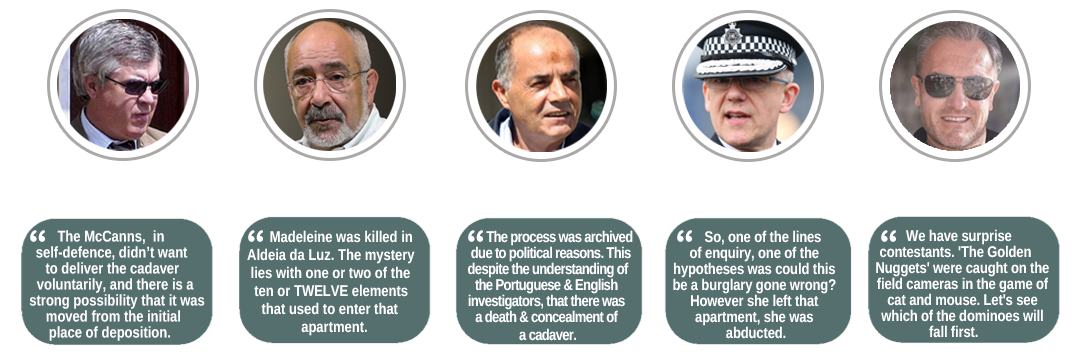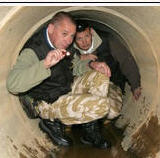McCann - dogs find body !
Page 2 of 2 • Share
Page 2 of 2 •  1, 2
1, 2
 Re: McCann - dogs find body !
Re: McCann - dogs find body !
The canine nose
The dog’s nose consists of a bony nasal cavity that is divided into two separate chambers by a bony and cartilaginous nasal septum. Within each of the cavities are the turbinate bones (conchae) and the paranasal sinuses.
The turbinate bones form into several scrolls of moveable cartilage and bony tissue that is lined with ciliated epithelial cells. The turbinate bones are a veritable maze of structure, and locating a foreign body hidden in their depths can be an extremely frustrating undertaking – a procedure that almost always requires general anesthesia.
The nose opens to the exterior via two external “nares” or nostrils and the ethmoid bone marks the posterior aspect of the nose.
The paranasal sinuses are extensions of the nasal cavity and various diseases or tumors may impair their drainage (especially of the frontal sinuses). When the dog sniffs, there is forced inspiration and the nostrils are dilated. The inspired air is warmed and humidified as it passes through the turbinates, and the mucus layer that lines the air passages serves as a filter to trap bacteria and particulate matter.
The dog collects scents by air-scenting (sniffing volatile oils that are traveling in the air) and sniffing the ground. A dog’s nose is ideally made for sniffing – the outer nares are mobile and allow for expansion on inspiration and contraction to prevent the entry of unwanted objects. When a dog sniffs, he inhales the scented chemicals into his nasal cavities, where they are trapped in mucus and processed by the sensory cells. Expiration forces air out the side of the nares so that its exit doesn’t interfere with odors still in the air or on the ground.
Several cilia extend from each of the sensory cells into the nasal cavity, and each of these cilia contains many scent receptors. After the cell receptors trap the smells, each cell has several (10 to 100) axons that deliver their messages back through the ethmoid bone directly to the olfactory bulb of the brain.
Once in the olfactory bulb, scents are transported to the frontal cortex for recognition as well as to other regions of the brain that include the brain’s centers for emotions, memory, and pleasure. There are many interconnections between all these centers, with the result that a simple smell, detected by a dog, likely has an entire set of meanings, memories, and emotional ties that only that dog can know and interpret.
Much of the deeper work of trying to understand the sense of smell has been done on humans; how do you ask a dog what he feels or remembers when he smells a certain odor? But we do know that dogs have much more surface area within their nasal cavities, and this area is well supplied with sensory cells – estimates of the total number of these cells vary and depend on the breed, but they have been cited as somewhere between 125 million and several times that. (This compares with estimates of human numbers that are in the 5- to 10-million-cell range.)
In addition, the dog has devoted a tremendous amount of his brain tissue to olfactory cells. (Some estimates allocate one-third of the dog’s brain to the chore of scenting.) All this adds up to a canine scenter that has thousands to millions of times the ability of his human counterpart.
We also know that we can use the dog’s incredible sense of smell to benefit mankind in ways we are only beginning to imagine. Today’s working scent dogs are involved in search and rescue (some dogs can follow a trail that is more than a week old), finding cadavers (dogs have even detected drowned people in a depth of 80+ feet of water), detecting explosives, firearms, and drugs, and even scenting tumors in human patients. Early work has begun to use dogs to test the breath of humans – to help diagnose internal diseases before they become evident with other methods.
from:
http://www.whole-dog-journal.com/issues/7_11/features/Canine-Sense-of-Smell_15668-1.html
The dog’s nose consists of a bony nasal cavity that is divided into two separate chambers by a bony and cartilaginous nasal septum. Within each of the cavities are the turbinate bones (conchae) and the paranasal sinuses.
The turbinate bones form into several scrolls of moveable cartilage and bony tissue that is lined with ciliated epithelial cells. The turbinate bones are a veritable maze of structure, and locating a foreign body hidden in their depths can be an extremely frustrating undertaking – a procedure that almost always requires general anesthesia.
The nose opens to the exterior via two external “nares” or nostrils and the ethmoid bone marks the posterior aspect of the nose.
The paranasal sinuses are extensions of the nasal cavity and various diseases or tumors may impair their drainage (especially of the frontal sinuses). When the dog sniffs, there is forced inspiration and the nostrils are dilated. The inspired air is warmed and humidified as it passes through the turbinates, and the mucus layer that lines the air passages serves as a filter to trap bacteria and particulate matter.
The dog collects scents by air-scenting (sniffing volatile oils that are traveling in the air) and sniffing the ground. A dog’s nose is ideally made for sniffing – the outer nares are mobile and allow for expansion on inspiration and contraction to prevent the entry of unwanted objects. When a dog sniffs, he inhales the scented chemicals into his nasal cavities, where they are trapped in mucus and processed by the sensory cells. Expiration forces air out the side of the nares so that its exit doesn’t interfere with odors still in the air or on the ground.
Several cilia extend from each of the sensory cells into the nasal cavity, and each of these cilia contains many scent receptors. After the cell receptors trap the smells, each cell has several (10 to 100) axons that deliver their messages back through the ethmoid bone directly to the olfactory bulb of the brain.
Once in the olfactory bulb, scents are transported to the frontal cortex for recognition as well as to other regions of the brain that include the brain’s centers for emotions, memory, and pleasure. There are many interconnections between all these centers, with the result that a simple smell, detected by a dog, likely has an entire set of meanings, memories, and emotional ties that only that dog can know and interpret.
Much of the deeper work of trying to understand the sense of smell has been done on humans; how do you ask a dog what he feels or remembers when he smells a certain odor? But we do know that dogs have much more surface area within their nasal cavities, and this area is well supplied with sensory cells – estimates of the total number of these cells vary and depend on the breed, but they have been cited as somewhere between 125 million and several times that. (This compares with estimates of human numbers that are in the 5- to 10-million-cell range.)
In addition, the dog has devoted a tremendous amount of his brain tissue to olfactory cells. (Some estimates allocate one-third of the dog’s brain to the chore of scenting.) All this adds up to a canine scenter that has thousands to millions of times the ability of his human counterpart.
We also know that we can use the dog’s incredible sense of smell to benefit mankind in ways we are only beginning to imagine. Today’s working scent dogs are involved in search and rescue (some dogs can follow a trail that is more than a week old), finding cadavers (dogs have even detected drowned people in a depth of 80+ feet of water), detecting explosives, firearms, and drugs, and even scenting tumors in human patients. Early work has begun to use dogs to test the breath of humans – to help diagnose internal diseases before they become evident with other methods.
from:
http://www.whole-dog-journal.com/issues/7_11/features/Canine-Sense-of-Smell_15668-1.html

Guest- Guest
 Re: McCann - dogs find body !
Re: McCann - dogs find body !
On the last Silent Witness story there was a dramatic scene of cadaver dogs arriving at a forest clearing. As each dog entered the scene it sniffed around and then sat down at a particular spot which collectively formed a horseshoe pattern. Very dramatic.

mysterion- Posts : 361
Activity : 403
Likes received : 14
Join date : 2013-11-08
Page 2 of 2 •  1, 2
1, 2
 Similar topics
Similar topics» Sniffer dogs used in search for Madeleine McCann found missing Orkney man's body
» Those unreliable dogs...
» Pamela Jackson: Body found (using police dogs) in hunt for mum missing for nearly three months
» MORE Useless dogs
» McCann Body Language
» Those unreliable dogs...
» Pamela Jackson: Body found (using police dogs) in hunt for mum missing for nearly three months
» MORE Useless dogs
» McCann Body Language
Page 2 of 2
Permissions in this forum:
You cannot reply to topics in this forum


































